
Should You Have Your Guitar or Bass Professionally Set Up?
If your brand-new or years-old guitar sounds off, it might not be your playing. Basic setup and maintenance are crucial for a guitar or bass to sound and play its best, even if you’re just starting out. But is it necessary to pay someone (either at the time of purchase or well into the life of an instrument) to set it up for you, or is it okay to do it yourself?
What does it mean to set up a guitar or bass?
Guitars and basses are largely wooden instruments under tension from strong metal strings, and they must balance these forces to remain in tune and play properly. The goal of setup is to make sure a new guitar or bass sounds and plays its best, or to get your longtime favorite playing as well as it did the day you bought it. That means no buzzes on any string at any fret, the same intonation accuracy across the whole fretboard, and string height that’s correct for your specific playing style (for most beginners, this typically means “low”), among other things.
Multiple adjustments are covered under the broad term “setup,” and not all of them may be necessary for your particular instrument. Some adjustments can be done by a beginner, but others require expertise or special equipment—or both.

Truss rod: The truss rod affects the guitar’s string height, or “action.” If the action is too high, the instrument can be hard to play. If it’s too low, the strings can buzz at certain frets. The truss rod is a strong metal rod located inside the neck of most modern guitars and basses that counteracts the tension created by the strings. If this were an archer’s bow, the truss rod would be the bow and the strings would be, well, the string. Adjusting the truss rod essentially raises or lowers the strings on the midsection of the fretboard by adjusting how much curve, or relief, the neck has.
Nut: At the top of the neck, after the strings leave the tuners, there’s a thin piece of (usually off-white) material over which the strings lie. This is called the nut. It keeps the strings in place, both horizontally and vertically off the fretboard. The nut, along with the bridge, at the other end, offers per-string adjustments to height, compared with the “global” adjustment of the truss rod. Making adjustments to the nut requires physical alterations through filing, and changes can’t be undone without replacing the nut.
Bridge: The bridge is the nut’s counterpart at the other end of the strings. Depending on the guitar’s design, the strings could end here, or they could pass through the body or to a separate tailpiece. The bridges on most electric guitars and basses offer as many as three adjustments: global string height, individual string height, and string length.
String length adjusts intonation, which refers to how in tune the notes are along the entire fingerboard, not just an open string. Without proper intonation your guitar would measure in tune on your tuner, sound fine with most chords, but then sound off the higher up the neck you played. To give an exaggerated example of poor intonation, you might tune the open string to E, but when you played the 12th fret, it would be an E flat instead. Getting this right is obviously very important.
Acoustic guitars typically don’t have the bridge adjustments of their electric counterparts, instead having a saddle that is similar to the nut at the top of the neck. This isn’t as easy to adjust (something we’ll discuss in the next section).
Frets and fretboard: With any luck a new guitar or bass won’t need much work on the frets (the metal bars across the neck) or the fretboard (the rest of the neck’s front side). But it can sometimes be necessary to smooth rough frets and otherwise ensure that they’re all uniform. If one fret is slightly out of place, it could rub against your fingers when you’re playing or create a buzz when you’re playing certain notes or chords. This is also true of older guitars that may have irregularly worn frets. Smoothing is usually done with steel wool, although playing a new instrument for a few weeks may get the job done.
At this point you may be curious about why we haven’t mentioned ukuleles, since we have a guide on them and they’re similar in many ways to guitars. Setup isn’t as critical with ukes because they’re rarely played above the seventh fret, and almost none of them offer the adjustments we’ve described here. Also, in our experience, nearly all of the ones we’ve tested played pretty well out of the box.
Which adjustments may require professional setup?
Several of the adjustments we described above may be too challenging for a beginner.
Truss rod adjustment: Some require a screwdriver; others require a hex wrench. On some guitars the truss rod is difficult to access.
Nut adjustment: This is probably the most challenging adjustment for a beginner—and the one most likely to get you into trouble if something goes wrong. Filing down the nut requires special files and a skilled, patient hand. There’s no simple reset if you file the nut down too far. Building the nut back up may require replacing it or shimming under it.
Bridge adjustment: On many electric guitars the bridge is adjustable, as long as you have a good tuner, a tiny screwdriver or hex wrench, and a steady hand. If you have a floating bridge (that is, one with a “whammy bar”), there are additional considerations that make the process more complex.
On most acoustic guitars, the bridge (really, the saddle) tends to be similar to the nut, requiring careful physical alterations to adjust the action. Adjusting intonation is even more difficult and may require replacing the saddle or, in extreme cases, moving the bridge.
How much will a professional setup cost?
Most musical-instrument stores offer their own setups or will refer you to someone nearby. The price will vary by region and by how much work the guitar or bass needs. Generally speaking, a professional setup costs around $50, but it could be upwards of $100 if there’s a lot of work to be done.
New strings are usually part of the setup process, since the gauges of the strings affect intonation. This expense may be included in the setup cost or it may be an additional charge—be sure to ask.
Most shops will likely add in a thorough cleaning, hydrating, and polishing, and perhaps a spritz of contact cleaner on any electronics.
So is it worth it to hire a professional?
Our musical-instrument writers collectively have well over a century of guitar and bass experience, and we have tested dozens of guitars and basses for our various guides. Our answer to whether you should have your instrument professionally set up: It depends.
If you’re an absolute beginner who didn’t know the nut from the bridge before reading this article, you should probably go the professional route. There are plenty of tutorials online that can teach you how to make different adjustments, but if you get a setup done by a professional first, you’ll at least have a baseline of how your guitar or bass should perform. If over time the instrument no longer plays the same way, you can either have it set up again or you can spend the time learning how to do it yourself.
Deciding on whether to get a professional setup also depends on what instrument you’re buying, and where you’re buying it. Electric guitars and basses have a wide range of adjustments that require only a bit of knowledge and some easily available tools. Acoustic guitars are far more challenging for a beginner to set up. If you’ve never set up a guitar before, an acoustic guitar probably isn’t the place to start.
If you’re buying a guitar or bass off of the Internet, the out-of-the-box setup may be more questionable, so it could be worth spending a bit of money to get the instrument playing its best. The lower the price of an instrument, the less likely it is that the manufacturer took time at the factory to get the best action and intonation—and brick-and-mortar stores generally can’t afford to do setup on inexpensive models, either. If you get the instrument and it’s unplayable—or it becomes unplayable or buzzy after only a few weeks of use—that’s a red flag, and you should probably return it. If a guitar or bass plays pretty well out of the box, it’s possible (perhaps even likely) that a bit of setup will get the instrument playing even better.
Further reading
The Best USB Audio Interfaces for Musicians and Podcasters
by Brent Butterworth
If you’re serious about recording high-quality music or podcasts, a great USB audio interface—like Focusrite’s Scarlett 2i2 or Vocaster Two—is a vital tool.
The Best Ukulele for Beginners
by Brent Butterworth
The Kala Satin Mahogany is our favorite starter uke for beginners. It sounds good, is easy to play, and comes in concert and soprano sizes.
The Best Home Bluetooth Speaker
by Brent Butterworth
Klipsch’s The One Plus Bluetooth speaker is a great way to get full, satisfying sound in your home with no need for complicated setup.
The Best Karaoke Machines
by Thom Dunn
After months of research and straining our vocal cords, we think the Tonor K20 Wireless Karaoke Machine is the best karaoke machine for most people.



